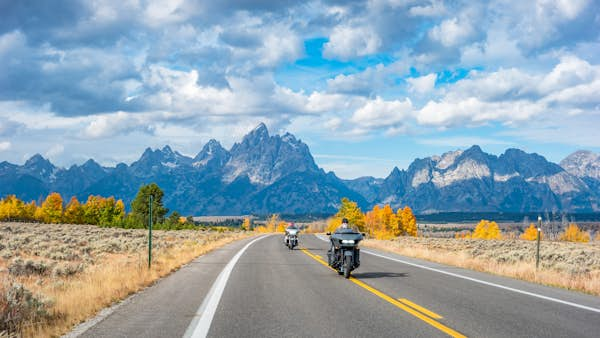The best time to visit Jackson Hole, Wyoming
6 min read
Surrounded by the towering peaks of the Tetons and the Gros Ventre Range, Jackson Hole is a true mountain destination. As such, the weather and the activities vary greatly from season to season.
Winter means feet of fluffy white powder that’s ideal for skiing and snowboarding, while summers are mild, sunny and perfect for hiking and mountain-biking. Come autumn, Jackson Hole is ablaze with dancing yellow aspens. Spring is a shoulder season, meaning you can score budget deals on lodging and have more of Jackson Hole to yourself.
Plan your visit Jackson Hole with this seasonal guide.
June to August is best for hiking and Wild West festivals
Summer is peak season in Jackson Hole. As the gateway to Grand Teton National Park and Yellowstone National Park, the valley welcomes lots of outdoorsy families while the kids are out of school. While the weather is near-perfect, you’ll also likely encounter traffic jams, full parking lots, crowded hiking trails and pricey accommodations.
The weather is sunny, breezy and mild, without the stifling humidity you find in destinations at lower elevations. Jackson Hole sees daytime temperatures in the 70°Fs and 80°Fs, then cools off considerably once the sun dips behind the Tetons. (Bring a jacket, because evenings can dip into the low 40°Fs.) It’s common for thunderstorms to roll in over the mountains in the afternoons, showering the valley with a quick burst of refreshing rain.
As the snow melts away in the high country, colorful wildflowers begin to emerge. Enjoy them while hiking, mountain biking, rock climbing, birding, camping and more. All of that snowmelt trickles into the Snake River, creating class II-IV rapids in the process. Book a white water rafting or scenic float trip with a local outfitter, like Dave Hansen Whitewater or Teton Whitewater.
If the timing of your trip lines up, you can also attend fun festivals and events, many of which shine the spotlight on Jackson Hole’s Wild West roots. The Jackson Hole Rodeo runs from Memorial Day to Labor Day, while the Teton County Fair spans nine days in late July. In Jackson’s famous antler-adorned Town Sq, you can catch nightly “shootouts” (performed by actors from the Jackson Hole Playhouse) every evening except Sundays. Both Snow King Mountain Resort and Jackson Hole Mountain Resort host outdoor concerts throughout the summer.

September to October is best for golden aspens and mountain biking
The summer crowds start to thin out in September, just as temperatures drop into the 60°Fs and 50°Fs. Meanwhile, Jackson Hole’s aspen trees begin to turn gold in mid- to late September, though the exact timing varies from year to year. You can usually still catch a glimpse of the region’s bright yellow fall foliage into early October.
Fall is also mating season for Jackson Hole’s elk, a period known as the “elk rut.” If you listen closely, you’ll hear bugling, a loud, high-pitched vocalization bulls make to attract females. With hormones coursing through their veins, the males also like to strut their stuff and show off their antlers – you may even see them fighting each other.
Autumn’s cooler temperatures mean you won’t sweat quite as much while adventuring outside. It’s a particularly fun time to go mountain biking or road cycling, because you can ride for longer (and climb higher) without worrying so much about overheating. Hiking, camping, birding and other outdoor pursuits are also still options, but beware, you might bump into a black bear or a grizzly trying to fatten up before hibernation. Buy or rent bear spray, and educate yourself on what to do if you meet one on the trail.
There aren’t nearly as many events in Jackson Hole in the fall, but if you visit in September, you can catch the Fall Arts Festival. This 12-day bash, which has been running for more than four decades, brings top Western, landscape and wildlife artists to Wyoming for more than 50 events at local galleries.

November to March is best for skiing and other snowy adventures
Once the snow starts to fly, skiers and snowboarders begin flocking to Jackson Hole. Most come to shred the slopes at Jackson Hole Mountain Resort, a 2500-acre ski area with an impressive 4139ft of vertical drop. It’s steep, challenging and beloved by powder-chasers around the world.
Jackson Hole also has another, smaller (and more affordable) ski area called Snow King Mountain Resort. Situated right downtown, it’s ideal for families and beginners.
If you crave a more serene winter outing, you can go cross-country skiing, snowshoeing or hiking with microspikes. Winter is also an ideal time to admire the thousands of elk (plus coyotes, wolves, ermine, bighorn sheep and other creatures) who hang out at the National Elk Refuge just north of downtown Jackson. This 24,700-acre swath of protected public land is absolutely gorgeous when it’s blanketed with snow, and you can take it all in from the comfort of a horse-drawn sleigh.
Winter is another peak season for tourism in Jackson Hole. Hotels are full, traffic is hairy and restaurants are packed. But, because of the region’s abundant wilderness, you can also easily find a quiet spot away from the crowds to soak up a little winter serenity. And when you need to warm up, Jackson Hole has plenty of cozy coffee shops, art galleries and bookshops.

April to May is best for budget travelers and wildlife watching
Spring comes late in the mountains. In April, the Tetons are still covered in snow (and many people are still skiing), but everywhere else in the valley is a muddy, slushy mess, hence the nickname “mud season.” By May, the weather is starting to heat up but can still be wildly unpredictable.
If you don’t mind layering up or changing your plans at the last minute, spring can be an ideal time to visit Jackson Hole, especially if you’re on a budget. During this shoulder season, you can usually score good deals on lodging, and you won’t be elbowing other travelers for one of the famed saddle seats at the Million Dollar Cowboy Bar (except for during the Million Dollar Music Fest in late May).
Plus, if you visit in the spring, you can attend Elkfest, the largest auction of elk antlers on the planet. During this beloved annual event, buyers come from near and far to bid on elk antlers that are naturally shed during the winter at the National Elk Refuge. The proceeds benefit the refuge, as well as local boy and girl scouting programs. If you’ve always wanted to make your own antler chandelier, this is your best bet, as there are strict rules around collecting shed antlers in the wild, especially if you don’t live here.
Spring is also a good time to visit if you love watching wildlife. Migrating birds, like boldly colored western tanagers and dainty hummingbirds, are passing through on their way to higher elevations. Birds of prey, including bald eagles and ospreys, are nesting and tending to their chicks. Baby mammals – including wolf pups and elk calves – are starting to explore the world around them. View them all safely and from a respectful distance with the experienced guides working for companies like Jackson Hole EcoTour Adventures or Jackson Hole Wildlife Safaris.





